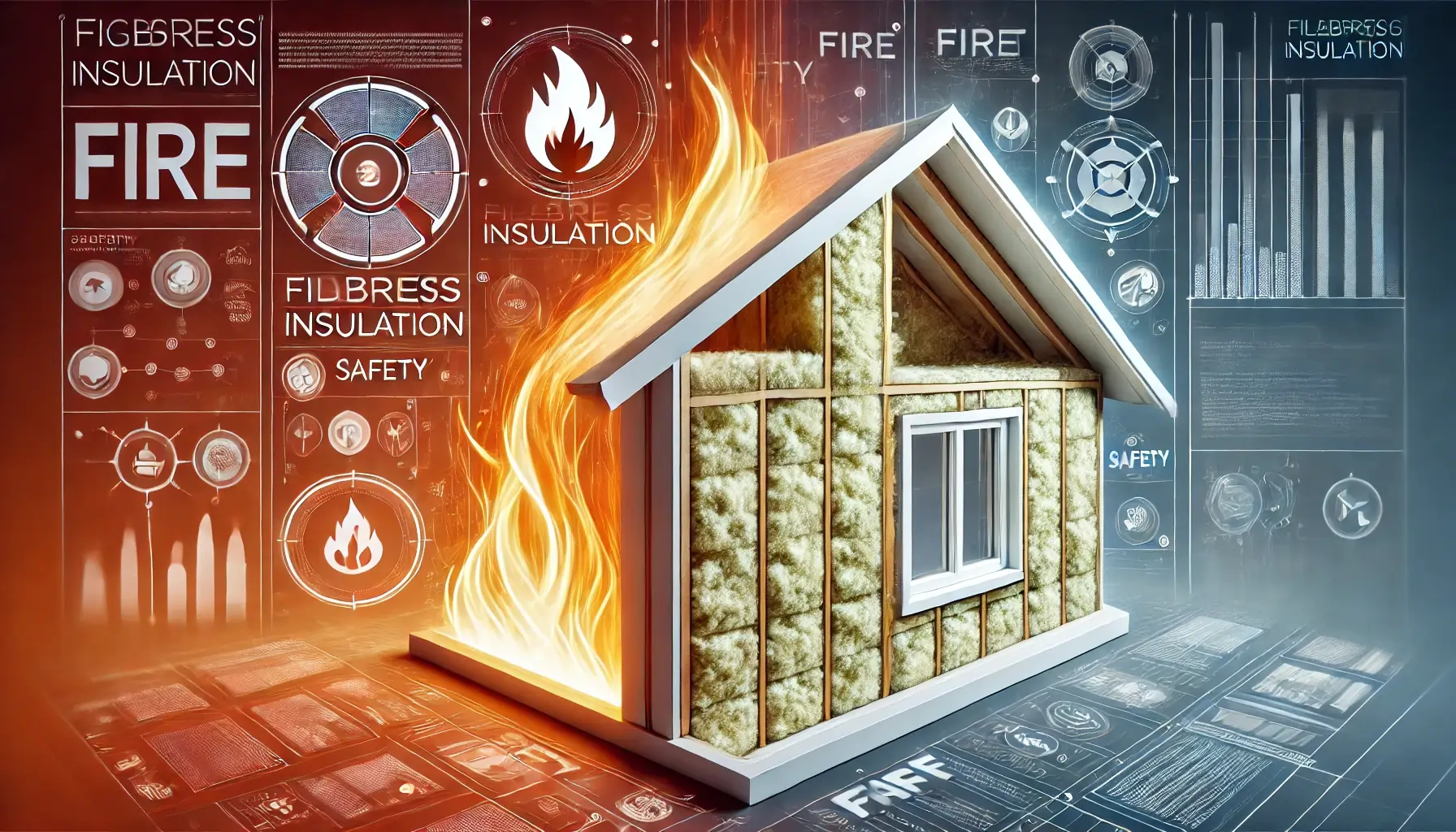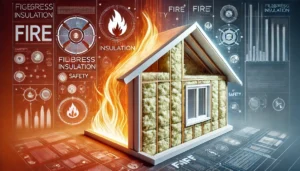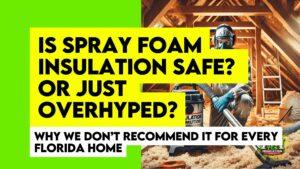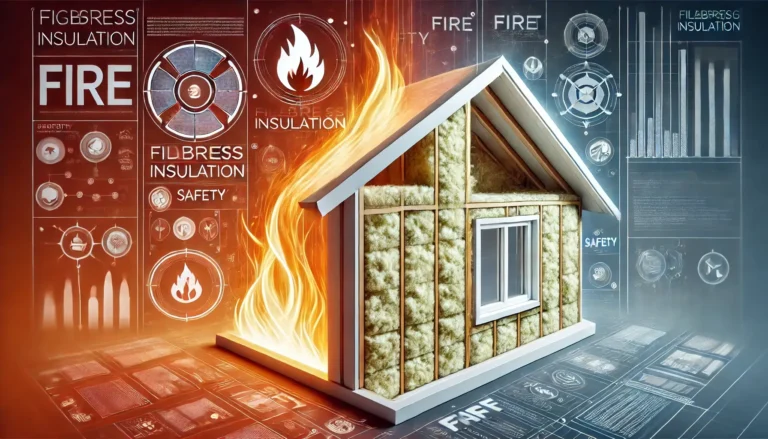Summary: Fiberglass insulation is non-combustible, but its binder resin and facings may burn. It meets Class A fire ratings (ASTM E84) and complies with Florida Building Codes for fire safety
According to the North American Insulation Manufacturers Association (NAIMA), fiberglass insulation is non-combustible, meaning it does not contribute to fire spread. Composed of tiny glass fibers, it can withstand high temperatures without burning, making it an ideal choice for enhancing fire safety in homes.
However, facings like kraft paper or foil may affect overall fire resistance, especially when exposed to heat. Both blown-in and batts fiberglass variants are non-flammable, but their facings and resin binders can combust under extreme conditions.
But, generally, is fiberglass insulation flammable? No, fiberglass insulation is non-flammable and fire-resistant as per ASTM E84 standards.
Understanding the flammability of insulation materials is crucial for homeowners seeking to improve both fire safety and energy efficiency. Let’s dive into the melt point, fire ratings, and the common myths about fiberglass insulation compared to other materials.
Can Fiberglass Insulation Burn? Exploring Fireproof and Fire-Resistant Properties
Key Takeaways:
- Fiberglass insulation (the glass fibers) is non-combustible; it does not ignite under typical building fires.
- Caution: Facings (kraft paper/foil scrim) and binder resins can burn or char, producing smoke until consumed.
- Rating: Most residential fiberglass batts are Class A (ASTM E84) with Flame Spread ≤25 and Smoke ≤50 (check product spec).
- Heat: Glass fibers soften before they melt; the binder can burn off around high heat, so batts may slump or lose cohesion.
- Safe installs: Keep clearances at chimneys/flues; use IC-rated recessed lights; follow FBC/IRC and manufacturer instruction
- Fireproof vs. Fire-Resistant: Fireproof refers to materials that are completely non-combustible and can withstand extreme temperatures without deteriorating, such as mineral wool. Whereas Fire-Resistant means materials that resist ignition and prevent fire spread but may burn or degrade under prolonged exposure, such as fiberglass insulation with resin binders.
- Smoke Developed Index (SDI): It measures the amount of smoke a material emits when exposed to fire. A low SDI indicates minimal smoke production, enhancing indoor air quality and safety. Fiberglass insulation typically has a low SDI, meaning it produces less smoke than more combustible materials like cellulose.
- Flame Spread Index (FSI): This matrix measures how quickly flames travel along the surface of a material. A lower FSI indicates slower flame spread, making the material safer in fire-prone areas like attics or walls. Fiberglass batt insulation has an FSI of ≤25, placing it in the Class A (best) fire rating category.
- Softening Point: The softening point is the temperature at which a material begins to lose its rigidity and becomes moldable. For fiberglass, it occurs between 1300°F–1400°F. Softening does not mean melting; instead, the fiberglass fibers lose their shape but do not fully liquefy, maintaining structural integrity under heat.
- Melt Point: The melt point refers to the temperature at which a material transitions from solid to liquid. For fiberglass, the melt point typically falls between 1400°F–1500°F, depending on the resin and facing material. Fiberglass insulation is designed to resist melting and maintain its insulating properties in extreme conditions, unlike more combustible materials like spray foam.
| Insulation Material | Flame Spread Index (FSI) | Smoke Developed Index (SDI) | Combustibility | Fireproof/Fire-Resistant |
|---|---|---|---|---|
| Fiberglass Insulation | ≤ 25 | ≤ 50 | Non-combustible | Fire-Resistant |
| Mineral Wool | ≤ 25 | ≤ 50 | Non-combustible | Fire-Resistant |
| Spray Foam (Open Cell) | ≤ 25 | ≤ 450 | Combustible | Fire-Resistant |
| Spray Foam (Closed Cell) | ≤ 25 | ≤ 250 | Combustible | Fire-Resistant |
| Cellulose (with retardants) | ≤ 25 | ≤ 450 | Combustible | Fire-Resistant |
At What Temperature Does Fiberglass Insulation Melt?
Fiberglass insulation typically softens around 1300°F–1400°F, but it does not fully melt until temperatures reach 1400°F–1500°F. The fiberglass fibers themselves are non-combustible, meaning they will not ignite or burn under typical fire conditions.
However, the binder resin that holds the fibers together can break down and burn at lower temperatures, potentially affecting the insulation’s performance.
Fire retardant fiberglass is treated to resist burning, making it ideal for areas that require enhanced fire safety. The ASTM E84 flame spread index and smoke developed index ratings ensure that fiberglass insulation remains Class A rated, offering the best fire protection in residential applications.
| Material | Softening Point (°F) | Melt Point (°F) | Can It Burn? | Temperature Limit (°F) |
|---|---|---|---|---|
| Fiberglass Insulation | 1300–1400 | 1400–1500 | No | 1800 |
| Mineral Wool | 1500+ | 1800+ | No | 2200 |
| Spray Foam (Open Cell) | 250–300 | 450–500 | Yes | 200 |
| Spray Foam (Closed Cell) | 250–300 | 500–550 | Yes | 250 |
| Cellulose (with retardants) | 350–400 | 450–500 | Yes | 250 |
Understanding Fiberglass Insulation and its Composition
Fiberglass insulation is made by melting glass and spinning it into fine fibers that trap air, reducing heat loss by limiting thermal conduction and convection.
Composition and Properties of Glass Fibers
The glass fibers in fiberglass insulation are derived from sand and recycled glass, melted and extruded into fine strands.
These fibers are non-combustible, meaning they do not support flame spread. Fiberglass insulation typically holds a low flame spread index (FSI) and smoke developed index (SDI), making it a Class A fire-rated material under ASTM E84 standards.
It can withstand temperatures up to 1,000°F before the binder resin starts to degrade, ensuring that the insulation does not burn. Fire-retardant fiberglass further enhances its fire-resistant properties for high-heat environments.
How Fiberglass Insulation Works to Prevent Heat Loss
Fiberglass insulation’s effectiveness depends on its thickness and R-value, which determines its thermal resistance. Thicker insulation offers better heat retention, enhancing energy efficiency.
In addition to thermal performance, fiberglass insulation significantly contributes to fire safety. Its non-flammable nature ensures that it does not fuel or contribute to the spread of fires in homes, maintaining a safe environment. According to fire safety studies, fiberglass insulation does not increase fire risk in residential settings.
Fiberglass Insulation Fire Rating: Understanding ASTM E84 & Class A Ratings
Fiberglass insulation is widely recognized for its fire-resistant properties, and its fire rating is a key factor in determining its safety in homes and buildings. Understanding these ratings helps ensure that your insulation contributes to overall fire safety.
ASTM E84: The Standard for Fire Safety
ASTM E84 is the test standard used to evaluate how insulation materials behave when exposed to fire. It measures the Flame Spread Index (FSI) and Smoke Developed Index (SDI), which determine how quickly flames spread across a material’s surface and how much smoke it produces.
Fiberglass insulation typically earns a Class A rating, with an FSI ≤ 25 and SDI ≤ 50. This means fiberglass has minimal flame spread and low smoke production, making it an excellent choice for fire safety.
Class A Rating Explained
A Class A rating is the highest level of fire resistance, ensuring that fiberglass insulation resists fire spread better than other materials. This rating indicates that fiberglass is non-combustible under standard conditions, providing crucial protection in the event of a fire.
It plays an important role in fireproofing buildings, especially in areas like attics and wall cavities where heat buildup is common.
Firestop Materials & Thermal Barriers
Firestop materials and thermal barriers complement fiberglass insulation by preventing heat from passing through critical spaces, such as around ducts and vents. These materials work together to limit the spread of fire, containing it in specific areas to minimize damage.
Fiberglass insulation, when paired with firestopping solutions and thermal barriers, provides an added layer of protection that meets and often exceeds the fire safety standards required by building codes.
Florida Building Code (FBC) Compliance
In Florida, specific building codes apply to insulation materials, considering the region’s hot and humid climate. The Florida Building Code (FBC) requires materials like fiberglass to meet high fire safety standards.
Fiberglass insulation meets these requirements, making it a trusted choice for residential insulation in areas prone to high heat and storms.
Does Fiberglass Melt? Role of Fiberglass Insulation in House Fires
Unlike combustible materials, fiberglass insulation has a high melting point of around 1,000°F (540°C). The glass fibers themselves are non-combustible, meaning they won’t catch fire or release toxic gases under typical fire conditions.
Fiberglass insulation is known for its fire-resistant properties. According to the National Institute of Standards and Technology (NIST), it can delay heat transfer and slow fire spread in the event of a house fire, providing valuable escape time. Fiberglass absorbs heat energy without burning, ensuring it doesn’t contribute to the fire hazard.
Fire Safety Measures with Fiberglass Insulation
- Pairing with Fire-Resistant Materials: Combining fiberglass insulation with mineral wool offers enhanced fire protection. Mineral wool can withstand temperatures up to 2,150°F (1,177°C), making it ideal for areas like attics and furnace rooms.
- Electrical Wiring & Pipe Insulation: Properly insulating around wiring and pipes ensures no ignition risk from combustible materials. Fiberglass batt and blown-in insulation help prevent overheating and minimize fire hazards.
- Fire Retardants & Vapor Barriers: While fiberglass is inherently fire-resistant, adding fire retardants to surrounding materials like cellulose boosts overall fire safety. A vapor barrier helps prevent moisture buildup that could degrade insulation performance.
- Maintaining Proper Insulation Thickness: Ensuring the right insulation thickness maintains both energy efficiency and fire safety. Excessive insulation can trap heat, raising fire risks in certain areas.
Temperature and Fire Behavior in Attics & Other Spaces
| Location | Best Insulation Type | Temperature Extremes | Risk of Combustion | Best for Fire Safety |
|---|---|---|---|---|
| Attic (Hot) | Fiberglass, Mineral Wool | 100°F to 160°F | Low | Fiberglass (Fire-Resistant), Mineral Wool (Fireproof) |
| Walls (Moderate) | Fiberglass, Cellulose | 50°F to 100°F | Low | Fiberglass (Fire-Resistant) |
| Crawl Space (Cold) | Fiberglass, Mineral Wool | 20°F to 40°F | Low | Mineral Wool (Fireproof) |
| Near Furnace | Mineral Wool, Spray Foam | 150°F to 250°F | Moderate to High | Mineral Wool (Fireproof) |
Technical Recommendations for Homeowners
- Regular Inspection and Maintenance: Periodically check insulation for signs of damage or moisture intrusion. Replace compromised insulation to maintain both fire resistance and thermal performance.
- Compliance with Building Codes: Adhere to local building regulations, such as the International Residential Code (IRC), which specify requirements for flame spread index and the use of fire-resistant insulation materials.
- Professional Installation: Engage certified professionals insulation installing or upgrading Insulation. They can identify the best combination of insulation materials and ensure that installation does not inadvertently create fire hazards.
Frequently Asked Questions
Does fiberglass insulation burn or just melt?
Fiberglass insulation itself is non-combustible and does not burn. However, its binder resin can melt and degrade at around 400°F–500°F, but the fiberglass fibers themselves do not catch fire.
Is fiberglass insulation considered fireproof or fire-resistant?
Fiberglass insulation is fire-resistant, not fireproof. It resists flame spread and does not burn easily, but its binder resin can burn under extreme heat conditions.
Are kraft-faced batts flammable?
Yes, kraft-faced fiberglass batts are flammable. The kraft paper facing can burn, but the fiberglass fibers remain non-combustible. Proper installation ensures the facing does not contribute to fire spread.
What insulation is best near a furnace flue or fireplace chimney?
Mineral wool or fire-resistant fiberglass insulation is best for areas near a furnace flue or fireplace chimney due to their high temperature tolerance and non-combustible properties.
Can fiberglass touch recessed lights?
No, fiberglass insulation should not touch recessed lights unless they are IC-rated. IC-rated lights are designed to be in direct contact with insulation, preventing heat buildup.
What is a Class A fire rating (ASTM E84 ≤25/≤50) and does fiberglass meet it?
A Class A fire rating indicates the best fire resistance with an FSI (Flame Spread Index) of ≤25 and SDI (Smoke Developed Index) of ≤50. Fiberglass insulation typically meets this Class A rating, making it ideal for fire safety.
Is mineral wool more fire-resistant than fiberglass?
Yes, mineral wool is generally more fire-resistant than fiberglass because it can withstand higher temperatures (up to 2,150°F) without melting or burning, compared to fiberglass’s 1,000°F–1,500°F.
What should I do with smoke-contaminated insulation after a house fire?
After a fire, smoke-contaminated insulation should be removed and replaced. Fiberglass insulation can absorb smoke and odors, compromising its performance and indoor air quality. A professional insulation removal service is recommended.










